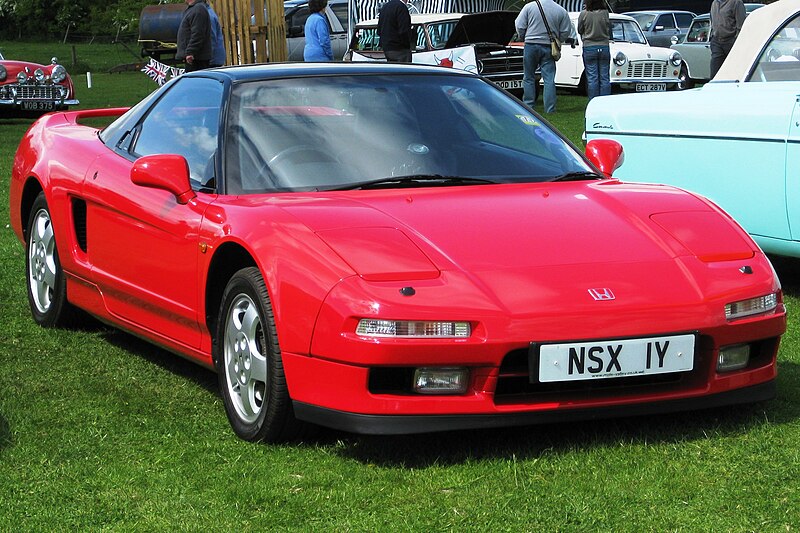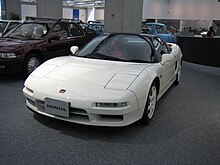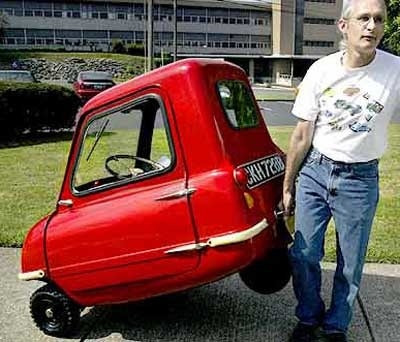A laundry list of car reviews, opinion pieces, technical articles and curated articles just for you!
11 May 2016
5 May 2016
Honda NSX
 |
| Source: https://commons.wikimedia.org/wiki/File:Honda_NSX_reg_1991_2977_cc.JPG |
What do you get if you take a Honda with Pininfarina-designed body panel and inject sporty DNA into it's vein to challenge the likes of Ferrari? The answer is the Honda NSX. Though it went into production in 1990, it's development began in 1984.
Tracing it's root back to 1984, Honda approached Pininfarina, an Italian coachbuilder, to commission the HP-X (Honda Pininfarina eXperimental) concept with a 2 litre V6 engine mounted amidship.
| Source: http://www.topspeed.com/cars/honda/1990-2005-honda-nsx-ar1449.html |
During it's development period, the Honda management figured they could create a supercar that rivals the performance of the Ferrari while offering stellar reliability and lower price tag. As a result, the HP-X concept evolved into the NSX (New Sportscar eXperimental).
Honda set the Ferrari 348 as a benchmark. To fulfill Honda's vision to put the 348 to shame, out goes the 2 litre V6 from the concept and in goes a more powerful mid-mounted transverse 3 litre VTEC DOHC V6 with a variable length intake manifold that churned out 270 bhp to the rear wheels via a 5 speed manual. The use of titanium connecting rod further optimised the output of the 'Ferrari burner'.
In the chassis department, the Honda engineers received a helping hand from the late triple F1 champion, Ayrton Senna who clinched the 1988, 1990 and 1991 title driving for the McLaren Honda team. Thanks to his input, the NSX chassis gained the much needed rigidity, and much beefier double wishbone suspension all-round, endowing Honda's answer to Ferrari with an impressive cornering speed.
Weight reduction played a crucial role to the NSX's quest to demonstrate its performance credibility. This called for aluminium body panel and aluminium suspension arms. The extensive use of aluminium endowed the NSX with a curb weight of 1370 kg.
 |
| Source: https://en.wikipedia.org/wiki/Honda_NSX_(first_generation)#1992_NSX-R_.28Japanese_domestic_market.29 |
Throughout it's production run from 1990-2005, the NSX had gone through several upgrades. Most notably was when the first iteration of the NSX-Type R, or NSX-R, was rolled out the assembly line in 1992 featuring a much larger, more powerful 3.2 litre V6 tuned by Mugen, extensive weight reduction, extra beefy suspension and a more aggressive final drive ratio up to 4.235:1 from the stock 4.06:1 for eyeball-popping acceleration. In 2002, the NSX Type R received a facelift which saw the introduction of carbon fibre to further cut weight and boosting power via engine tweaking. The result is a Nurburgring lap time of 7:56 rivalling the Ferrari F360 Challenge Stradale, set by a former Japanese racing driver and current Best Motoring presenter, Motoharu Kurosawa.
To this writer, the NSX is Honda's stepping stone to challenge the European performance icon. The recently launched second generation NSX with it's new powertrain represents the stride Honda has made to become a major player in the high performance car industry.
Bravo Aston!
 |
| Source: www.dubicars.com |
Okay, what is so special about Aston's new V12 Vantage S compared to the previous iteration? Well, it is not really Aston going bonkers with liberating extra juice from the same 6 litre V12 (it still makes the same 563 hp at 6750 rpm and 620 Nm of torque at 5750 rpm). What makes it special is the bit that passes the V12 power to the rear wheels, the transmission.
What is so special about the transmission I heard you ask? Well, the new V12 Vantage S is a departure from the previous model where manual was not even an option (only a 7 speed Sportshift III automated manual was offerred mind you). This time round our Gaydon friend has shoehorned...hold your breath...3 pedals and a human-operated H-gate shifter!
| Source: paultan.org |
To top it off, the transmission is equipped with the AMSHIFT, which automatically blips the throttle on downshift to simulate a clean heel toe downshift, made possible by clutch, gear position and propshaft sensor. If you wish to do your own heel toe, the system can be turned off.
The return of manual in the V12 Vantage S after a brief hibernation should be a welcome relief to the enthusiasts camp. The 7 speed Sportshift III automated manual remains an option in the new Vantage S if clutching in and out is not your idea of driving.
4 Mar 2016
Self-shifter 'GT3 RS', Porsche's commitment to the 3 pedal 911?
| Source: porsche.com/italy/models/911/911-r/ |
With the same 4 litre naturally aspirated flat-six derived from the track-going GT3 RS slung out at the back, your insatiable desire for tactile pleasure of feeling the cogs stirring under your palm, the 911 R will surely stroke your insistence for 'manualness' (do the word even exist?).
| Source: porsche.com/italy/models/911/911-r/ |
"It's a unique selling proposition for Porsche to have a manual in the 911 range, and I think we will fight for that as long as possible," he told Car And Driver. "Even if it's only 10 percent of the market, it's important for some customers and for some markets, especially the U.S., to have that kind of gearbox."
He also acknowledges the emotional appeal of flicking the gear lever.
"What we learned from the last two years with the Cayman GT4 and Boxster Spyder is that it's not only a discussion of lap times, but also of emotion, of being fun to drive," he said. "Even if the car is not the fastest, it is fun to drive with a manual. Of course the PDK is faster, but a lot of customers want to change gear by themselves. Therefore I think we should keep it, for the next generation also."
The 911 R is a sign of Porsche's dedication to keep manual in the 911 family as long as a sizeable number of customers ask for it.
Features treating future 911 R owners are automatic rev matching function which can be switched off by a press of a button and an optional single mass flywheel for extra zing when you gun the loud pedal.
Rear wheel steering and mechanical rear locking differential will ensure enhanced stability while you are busy heel toeing to gratification.
To keep 500 hp in check, Porsche Ceramic Composite Brake is standard for an eye-popping stopping power. With lap time not prioritised, the rear wing had been hacked off.
Features treating future 911 R owners are automatic rev matching function which can be switched off by a press of a button and an optional single mass flywheel for extra zing when you gun the loud pedal.
Rear wheel steering and mechanical rear locking differential will ensure enhanced stability while you are busy heel toeing to gratification.
To keep 500 hp in check, Porsche Ceramic Composite Brake is standard for an eye-popping stopping power. With lap time not prioritised, the rear wing had been hacked off.
Unlike certain automakers who had completely threw manual into the dumpster (Ferrari and Lamborghini comes to mind), Porsche has not completely given up on the row-your-own-gear option. The 911 R may well be a ray of hope for the manualphiles around the globe that the surge of the state-of-the-art, lap time 'special' automated transmission will not completely supplant the traditional tactility that 3 pedals and H-gate shifter provide to those who do not see clutching in and out as a humdrum chore.
Labels:
International Launch
,
Manual Transmission
,
Porsche
,
Technology
9 Feb 2016
BMW M hybrid in the offing? Will Munich implement hybrid in spite of weight handicap?
 |
| Source: qJake via Flickr CC BY-SA 2.0 |
Thanks to the likes of McLaren P1, Ferrari LaFerrari and Porsche 918 Spyder, performance sectors are giving hybrid their graceful touch. Formula E , Porsche Mission E concept and Mercedes AMG SLS Electric Drive give performance cars some nice zap of electric shock. Hybrid and electric powertrain are not only constrained in your run-of-the-mill family cruiser, but also in muscle-bound brute that spells P.E.R.F.O.R.M.A.N.C.E.
In an interview conducted by Auto Express, Dirk Hacker, vice president in the M division, admitted that hybridisation and electrification may be the future of M cars.
"We will look at electrification-I think it could be inevitable-but it depends on the possibility of increasing performance," Hacker said. He immediately noted that hybrid M will not be implemented right off the bat due to weight concern and will only consider hybrid if it offers performance improvement.
When asked on the possibility of electric M cars, Hacker dismissed the latter due to customer demand.
"We've found that our customers are not interested in driving without the combustion engine," Hacker said. "They want to know if these changes will help with performance." Seems like electric M is out of the question. Phew. This writer cannot imagine standing next to an eeriely quiet M car.
If that is the case, looks like our friend at BMW M is looking to hybridise their performance segment not in the name of efficiency but performance. The VP's concern on the weight of hybrid powertrain reminds this writer on Koenigsegg's chief concern during the development of their hallow Regera hybrid: weight.
Not surprisingly, weight is a performance killer. Shedding weight is a goal of every performance cars. Take for instance the likes of Ariel Atom 3.5R and Ferrari 458. The latter is more powerful than the former. However, the Atom sprints from 0-62 mph in just 2.6 seconds to the 458's 2.9 seconds. Wait a minute, how can the Atom with 350 hp 2 litre supercharged Honda 4 cylinders outgunned the 458 with its more powerful 562 hp 4.5 litre V8? The Atom only weighs 550 kg to the 458's 1485 kg. This emphasises in the performance realm, taking into account only power output is not enough. Power-to-weight ratio is the holy grail in making a car a speed demon. The VP's concern on hybrid drivetrain's weight may allude to boosting power-to-weight ratio.
This writer wonders if hybrid M do come into production, will the engineers at M division ponder on imitating Koenigsegg's trick in overcoming the weight handicap of their Regera hybrid: dispensing the transmission altogether. Will this be the recipe for crazy power-to-weight ratio?
30 Jan 2016
Koenigsegg's Freevalve camless engine
For decades since the advent of the Internal Combustion Engine, camshafts have been responsible for actuating the poppet valves (intake and exhaust) to draw air fuel mixture into the cylinder for combustion and purging the cylinder off spent gases, or exhaust gases, for the next intake of fresh mixture.
In the past, camshaft tuning was a compromise, meaning engineers had to take into account the engine's application: will it spend its time in bumper-to-bumper traffic or screaming itself off at higher rev range.
Several innovations had been invested to overcome the restrictive nature of camshafts such as variable valve timing and lift, an innovation that alters the opening and closing time of the valves (timing) and how far it opens (lift). However, it still does not change the fact that camshafts, like any mechanical devices, are analog in nature: meaning the valves lack individual control due to being solidly locked to the camshafts. Enter Koenigsegg's Freevalve camless engine.
In the past, camshaft tuning was a compromise, meaning engineers had to take into account the engine's application: will it spend its time in bumper-to-bumper traffic or screaming itself off at higher rev range.
Several innovations had been invested to overcome the restrictive nature of camshafts such as variable valve timing and lift, an innovation that alters the opening and closing time of the valves (timing) and how far it opens (lift). However, it still does not change the fact that camshafts, like any mechanical devices, are analog in nature: meaning the valves lack individual control due to being solidly locked to the camshafts. Enter Koenigsegg's Freevalve camless engine.
With the camless engine, rather than being actuated by a camshaft, the valves are actuated by high pressure air via pneumatic actuators. According to Christian von Koenigsegg, the founder of Koenigsegg supercar firm and a visionary who came up with innovative approaches such as the bonkers hybrid gearless Regera, traditional camshaft is akin to playing a piano with a broomstick and taking away the camshaft is akin to playing the piano with your fingers. Imagine taking a broomstick and try hitting the piano keys. You will find you have less control on which key to actuate as the broomstick will hit virtually all keys. Remove the broomstick and you have better control on which keys to actuate.
Going back to conventional camshaft engine, say you have 4 valves per cylinder (2 intake valves and 2 exhaust valves). Both intake valves are open simultaneously during the intake stroke and vice versa.
With the camless engine, the ECU does not necessarily open all valves but rather take into account engine load and rpm to open just one or two valves to ensure efficiency at varying engine operations. This entails better control over the actuation of valves and theoretically may boost performance and efficiency, which Koenigsegg claimed an improvement by 30%. A huge claim indeed.
Going back to conventional camshaft engine, say you have 4 valves per cylinder (2 intake valves and 2 exhaust valves). Both intake valves are open simultaneously during the intake stroke and vice versa.
With the camless engine, the ECU does not necessarily open all valves but rather take into account engine load and rpm to open just one or two valves to ensure efficiency at varying engine operations. This entails better control over the actuation of valves and theoretically may boost performance and efficiency, which Koenigsegg claimed an improvement by 30%. A huge claim indeed.
Most folks may be familiar with timing belt or timing chain. Camless engine dispose of the need for it as there are no camshafts. This may mean no more worries of the belt snapping at inopportune moment.
Evora S on steroid
What a day it had been at Lotus showroom. Though there was not much to be seen, the sight of a ferocious looking beast waiting to unleash its hidden power is satisfying to the eye of this writer. Pictured above is Lotus new model, christened the Evora 400. Well, technically it is Evora S with steroid coursing its vein.
What does that entail? Pop open the rear bonnet and you will be greeted by that gorgeous looking 3.5 litre supercharged Toyota V6, the same engine found on the Evora S, but Lotus fiddled with it to raise its output from 345 horsepower to 400 horsepower as implied by the '400' in its name.
All those powers are sent to the rear wheels via a six-speed automatic with paddle shifters. If you wish to be in charge of cog swapping, fear not as a six-speed manual is also available.
With such ginormous power in disposal, large brake discs will keep this car from wrapping itself around a tree.
There is nothing more satisfying than glancing in your rear view mirror, greeted by that roaring 'blown' V6 propped up just behind your rear windshield.
Subscribe to:
Comments
(
Atom
)







